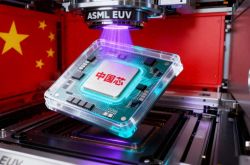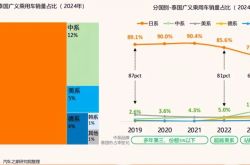Analysis丨The 'Race for a Foothold' in Quantum Technology Between China and the U.S.
![]() 11/03 2025
11/03 2025
![]() 437
437
Foreword: Several institutions predict that quantum technology will reach a pivotal turning point [from laboratory research to industrial application] within the next 5 to 10 years. McKinsey anticipates that by 2035, the quantum computing industry will generate $97 billion in revenue, with the global market for quantum technology potentially reaching $198 billion by 2040. Presently, the global landscape of quantum technology is characterized by a rivalry between two dominant powers—China and the U.S.—with the EU striving to catch up and other regions still in their nascent stages. However, China and the U.S. possess distinct strengths and follow different development paths.
Quantum Computing: From a Race for Computational Power to Ecosystem Positioning
In core hardware, China's [Zuchongzhi III], unveiled in December 2024, boasts 105 data qubits and processes random circuit sampling problems six orders of magnitude faster than Google's contemporary achievement, setting a new benchmark for quantum supremacy in superconducting systems.
China Telecom Quantum Group launched the [Tianyan 504] quantum computer, which, with 504 qubits, became the domestic superconducting quantum device with the highest single-machine qubit count.
Regarding ecosystem development, China Telecom Quantum's open-source programming framework, Cqlib, has established a technological closed loop from hardware to applications. The [Tianyan] quantum cloud platform, connected to an 880-qubit cluster, has facilitated over 1.6 million experimental tasks across more than 60 countries.
Application exploration is concentrated on pivotal areas of the national economy and people's livelihoods, collaborating with meteorological departments for precise precipitation forecasting and conducting algorithm validation in fields such as biochemistry and materials manufacturing.
In the realm of hardware, IBM in the U.S. has achieved breakthroughs in quantum error correction, with its quantum computers achieving an average fault-free runtime of 1,000 hours, ten times that of their Chinese counterparts. Google and Intel are exploring multiple technical routes, including superconducting and ion trap technologies, to create technological redundancy.
NVIDIA has collaborated with Google Quantum AI to expedite the design of next-generation quantum devices using 1,024 GPUs. Amazon AWS initiated the Quantum Embark program to lower the barriers for enterprises to utilize quantum services.
Quantum Communication: China's Absolute Advantage and the U.S.'s Counterbalance as a Latecomer
China's strategy prioritizes infrastructure development and the penetration of application scenarios.
Since the successful launch of the [Mozi] quantum satellite in 2016, China has constructed an integrated [space-ground] quantum communication network: on the ground, the [Beijing-Shanghai Trunk Line] connects major cities like Beijing and Shanghai, supporting secure communications in finance, government affairs, and other sectors;
In space, the [Jinan No.1] satellite has undergone performance upgrades, with a third quantum satellite planned for launch in 2026.
Industrial applications have transitioned from demonstration projects to large-scale deployment. China Telecom Quantum demonstrated the world's first operator-grade integrated space-ground quantum security infrastructure, enabling cross-domain quantum security.
QuantumCTek, as a leading enterprise, has established a full industrial chain from core devices to system solutions, dominating more than 20 domestic industry standards.
The U.S. adopts a [differentiated competition, standard positioning] strategy. Due to its late start in fiber-based quantum communication, the U.S. focuses on post-quantum cryptography and satellite-ground quantum communication technologies.
NIST leads the development of post-quantum cryptography standards, with four algorithms selected for the final phase. DARPA funds the [Quantum Network Challenge], focusing on the development of satellite quantum communication protocols.
At the industrial level, U.S. companies emphasize breakthroughs in upstream core technologies. L3Harris and others have developed high-performance quantum key distribution devices, while Microsoft researches quantum repeater technologies to address long-distance communication bottlenecks.
Technological Routes: U.S. Dominance in Computing, China's Strength in Communication
In quantum computing, the U.S. firmly holds the [computational power high ground] through the ecological advantages of tech giants.
Google's Willow superconducting quantum chip achieves single-qubit gate fidelity of 99.97% and entangled-gate fidelity of 99.88%, capable of performing millions of quantum measurements in tens of seconds.
IBM is even more aggressive, introducing the 1,121-qubit Condor processor and modular quantum computer IBM Quantum System Two, while also building the Qiskit programming framework, attracting 85% of global algorithm developers.
The U.S. pursues a diversified technological approach, with superconducting, ion trap, and neutral atom technologies advancing in parallel. IonQ's ion trap quantum computer has even achieved commercialization, allowing customers to directly access computational power via cloud platforms.
China, on the other hand, demonstrates explosive power in [single-point breakthroughs]. The [Zuchongzhi III] superconducting quantum prototype developed by the University of Science and Technology of China (USTC) team, led by Pan Jianwei, achieves [quantum supremacy] with 105 qubits, processing random circuit sampling tasks 15 orders of magnitude faster than the U.S. supercomputer Frontier and six orders of magnitude faster than Google's contemporary achievement.
Origin Quantum's [Wukong] superconducting quantum computer, equipped with 72 computational qubits and 126 coupling qubits, is freely accessible to global users, attracting over 4.77 million visits.
More critically, China also leads in the photonic quantum route. The [Jiuzhang III] manipulates 255 photons, solving Gaussian boson sampling problems billions of times faster than supercomputers, making China the only country in the world to achieve [quantum supremacy] in both superconducting and photonic quantum systems.
In quantum communication, China's leading position is virtually unshakable.
China has built the world's first quantum secure communication trunk line, the [Beijing-Shanghai Trunk Line], enabling intercontinental quantum secure communication;
The [Mozi] quantum satellite completed 1,200-kilometer satellite-ground quantum entanglement distribution, forming the prototype of an integrated space-ground network;
China Telecom has established quantum metropolitan area networks in 16 cities, with Hefei's network covering 1,147 kilometers and serving over 200 organizations and 6,600 clients.
By 2025, Chinese research teams completed module-level validation of a satellite-ground quantum direct communication system, laying the foundation for [space-air-ground integrated] communication and establishing China as the global leader in the commercialization of quantum communication.
Innovation Models: U.S. [Market-Driven] vs. China [State-Led]
The differences in quantum technology between China and the U.S. essentially reflect differences in their innovation systems. The U.S. follows a market-driven route led by corporations and supported by capital: tech giants like Google, IBM, and Microsoft invest heavily, while venture capital remains active. In 2024, U.S. quantum startups raised $1.754 billion in financing, over ten times that of China.
Companies like IonQ and Rigetti went public via IPOs or SPACs, with IonQ's stock price surging 13-fold in two years, reaching a market capitalization exceeding $10 billion, forming a virtuous cycle of [R&D-financing-commercialization].
Although the U.S. provides support through the [National Quantum Initiative Act], it primarily [builds platforms] without directly intervening in technological routes.
China adopts a [national strategy + research institutes + state-owned enterprise collaboration] model. Universities like USTC and Tsinghua University are the main R&D forces, with the National Natural Science Foundation of China funding nearly half of all quantum papers.
State-owned enterprises such as China Telecom and China Mobile are deeply involved. For example, China Telecom invested 1.8 billion yuan to become the controlling shareholder of QuantumCTek, promoting the integration of quantum communication with traditional communication networks.
Local governments in Hefei, Beijing, and Shanghai have established quantum special funds, with Hefei's Quantum Science Development Fund alone reaching 10 billion yuan in its initial phase. The advantage of this model lies in [concentrating resources to accomplish major tasks], enabling rapid breakthroughs in key technologies.
Patents and Capital: U.S. Leads in Quantity and Quality, China Accelerates Catch-Up
Patents serve as a [hard indicator] of technological strength. As of 2024, the U.S. had filed 18,600 quantum technology patents, accounting for 49.34% of the global total, with most concentrated in core quantum computing areas;
China ranked fourth with 7,601 patents, though its total lags behind the U.S., it ranks second globally in quantum communication patents and matched the U.S. in quantum computing patents by 2024.
LexisNexis predicts that if current growth rates continue, China could surpass the U.S. in comprehensive quantum patent strength as early as 2027.
The capital gap is even more pronounced, with U.S. quantum firms raising significantly more financing than Chinese counterparts: in 2024, PsiQuantum raised $625 million, and Quantinuum raised $300 million, together accounting for nearly half of global quantum financing.
Although Chinese firms like QuantumCTek and Origin Quantum have secured financing, the entire industry raised only $104 million in 2024, primarily from government funds.
However, China's state-capital advantages are becoming evident. Platforms like China Telecom and the National Supercomputing Internet provide application scenarios for quantum firms. QuantumCTek's revenue grew by 92% in the first three quarters of 2025, with net losses narrowing to 2.3 million yuan, indicating accelerated commercialization.
Each Has Shortcomings: The Future Competitive Landscape of the Industry
Despite their respective strengths in quantum technology industrial deployment, both China and the U.S. face technological bottlenecks and ecosystem shortcomings.
Future competition will no longer be a contest of single technologies but rather a comprehensive strength battle to overcome challenges and improve ecosystems.
China's core challenges lie in industrial chain autonomy and ecosystem marketization.
In the upstream industrial chain, the purity of niobium-titanium superconducting materials is only 99.9%, one order of magnitude lower than that of the U.S. While key equipment like dilution refrigerators has achieved domestic substitution, performance gaps remain.
At the ecosystem level, China needs to break free from [policy dependence] and cultivate market-driven demand.
The U.S.'s weaknesses stem from the backlash of technological blockades and high application costs.
The investment ban that took effect in 2025, while attempting to contain China, has also deprived U.S. companies of access to China's vast market. The French Institute of International Relations estimates that U.S. firms could lose $3 billion in potential revenue in the quantum communication sector.
Technological blockades have also caused the U.S. to miss out on international collaboration opportunities. The number of Sino-U.S. collaborative quantum academic papers has declined by 40% compared to 2020, slowing progress in fundamental research.
At the application level, the high cost of quantum devices restricts their popularization, with a single superconducting quantum computer costing over $10 million, making it unaffordable for small and medium-sized enterprises.
China's [15th Five-Year Plan] explicitly lists quantum technology as a [new economic growth point], aiming to [recreate another high-tech industry in China].
For China, quantum technology represents both a [litmus test for scientific and technological self-reliance] and an important carrier of [new quality productive forces].
Elevating quantum technology to the level of a new economic growth point means it is no longer confined to laboratory [black technology] but is destined to permeate various industries.
Conclusion:
From a long-term perspective, the competition in quantum technology between China and the U.S. will feature a coexistence of selective decoupling and conditional cooperation.
In areas involving global security, such as quantum communication standards and post-quantum cryptography, cooperation remains inevitable. In contrast, competition will intensify in core quantum computing hardware and quantum sensing.
However, regardless of the mode, one fundamental fact cannot be ignored: breakthroughs in quantum technology require global collaboration.
The purification of niobium-titanium materials demands technological exchanges across international laboratories, the optimization of quantum algorithms relies on the collective wisdom of global developers, and the exploration of application scenarios necessitates cross-industry collaborative innovation.
Partial references: Great Wall Strategy Consulting: 'Quantum Technology: The Next [Disruptive] Track in Great Power Competition'; Xiaoshu Reports: 'In-Depth Interpretation of Quantum Technology'; Quantum Information Branch of the China Information Association: 'China's Quantum Technology Industry Delivers Its Answer Sheet in the 14th Five-Year Plan'; Quantum Panorama: 'One Year After the U.S. [Blacklist], China's Quantum Technology Industry Accelerates'








